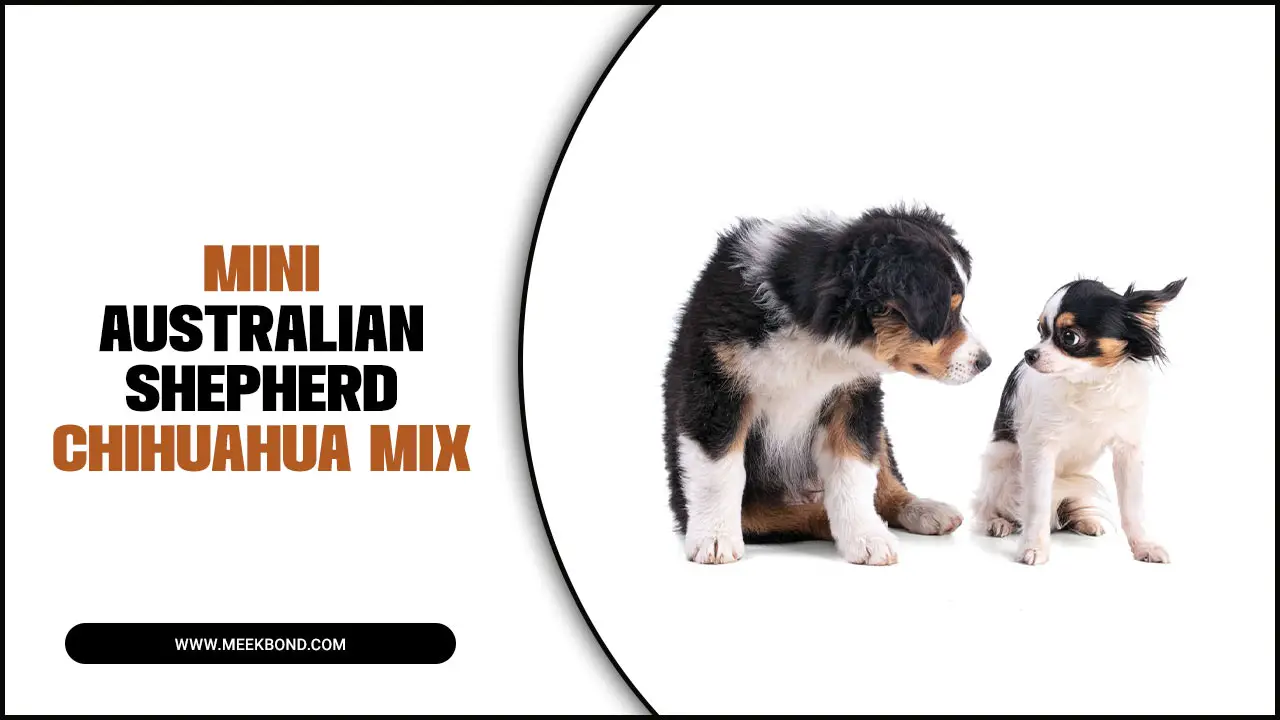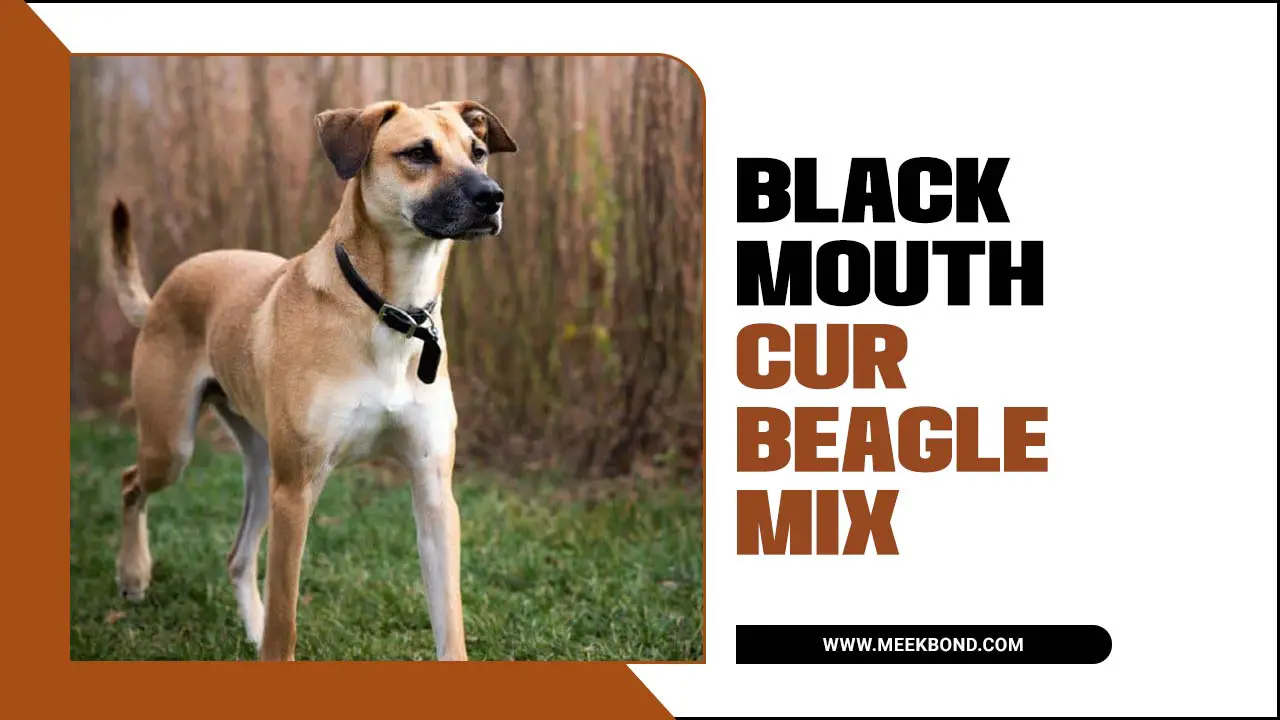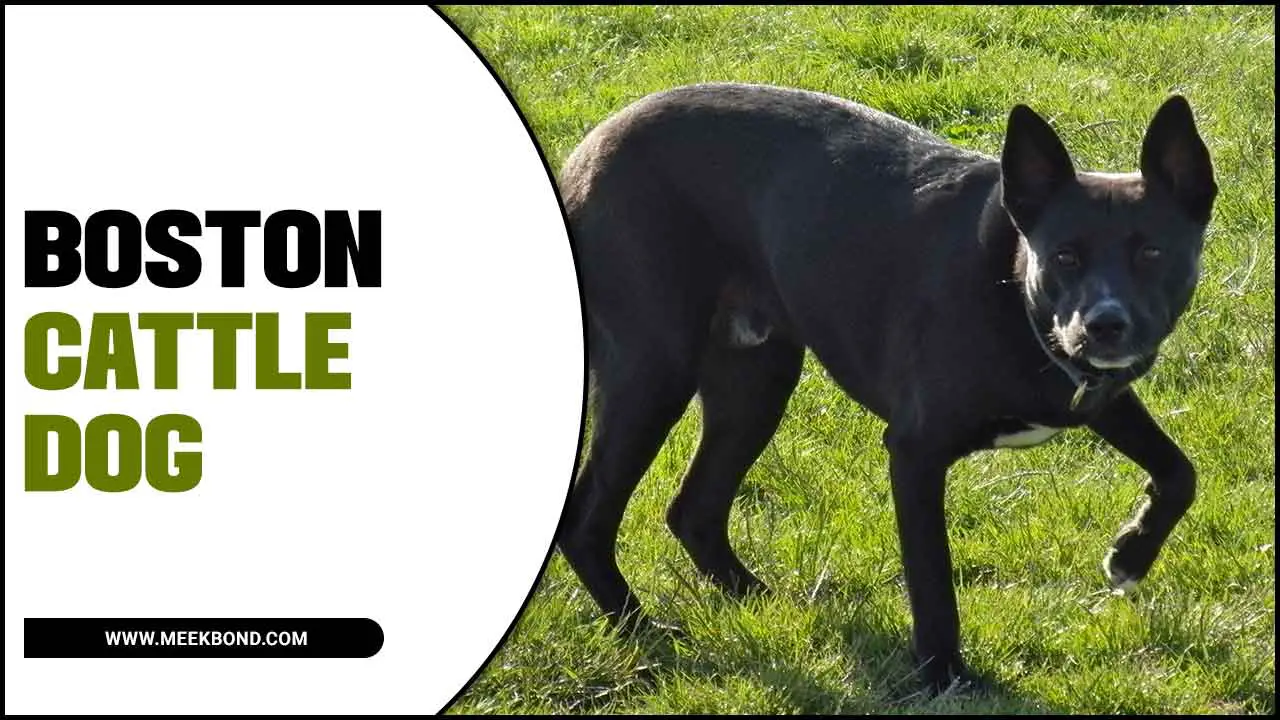When choosing a dog breed, compare the characteristics of Dobermans and Giant Schnauzers. Both breeds share qualities like intelligence, loyalty, and protectiveness. However, there are key differences to consider.
Dobermans are aggressive with a strong prey drive, making them excellent for guarding and protection. Giant Schnauzers are larger with a thicker coat, better suited for colder climates. Both breeds need training and socialization to prevent aggression. Consider your lifestyle and specific needs when deciding between these breeds. If you want a highly protective and alert dog, choose a Doberman.
Here we will compare these two breeds, doberman vs giant schnauzer, to determine which is better suited to your lifestyle. So, keep reading if you’re trying to decide between a Doberman or a Giant Schnauzer.
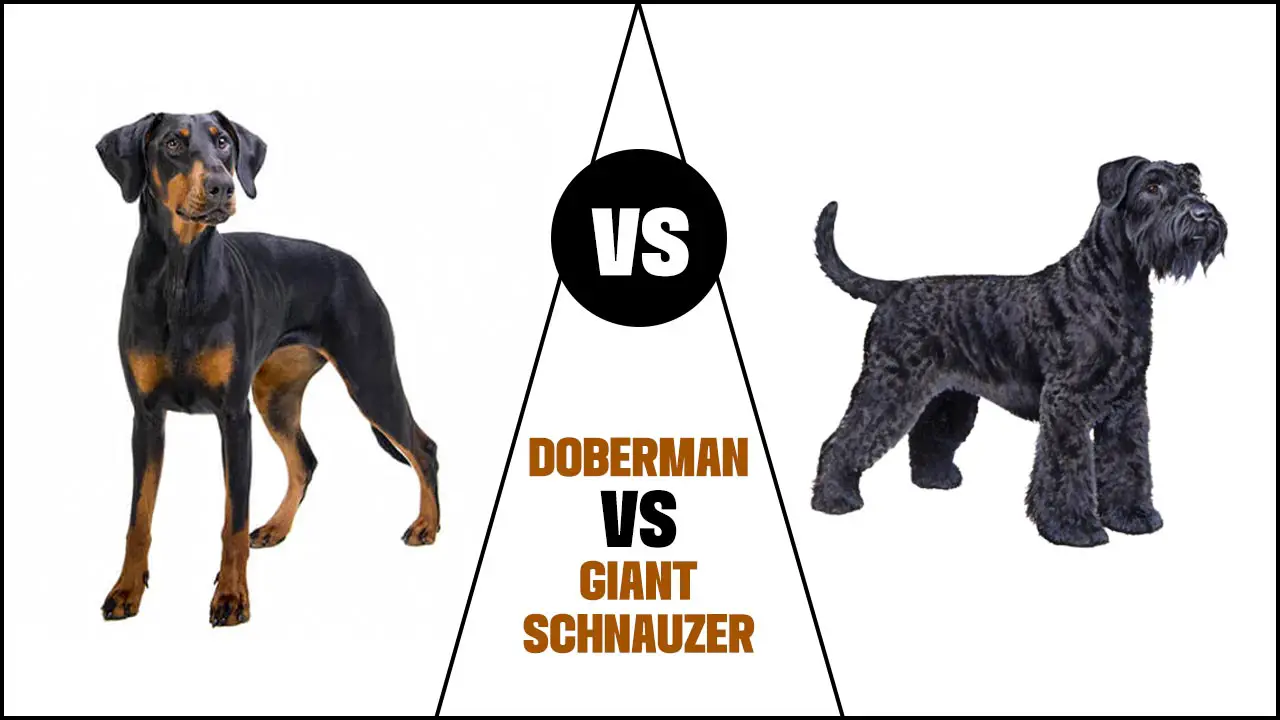
Overview Of Doberman Vs Giant Schnauzer
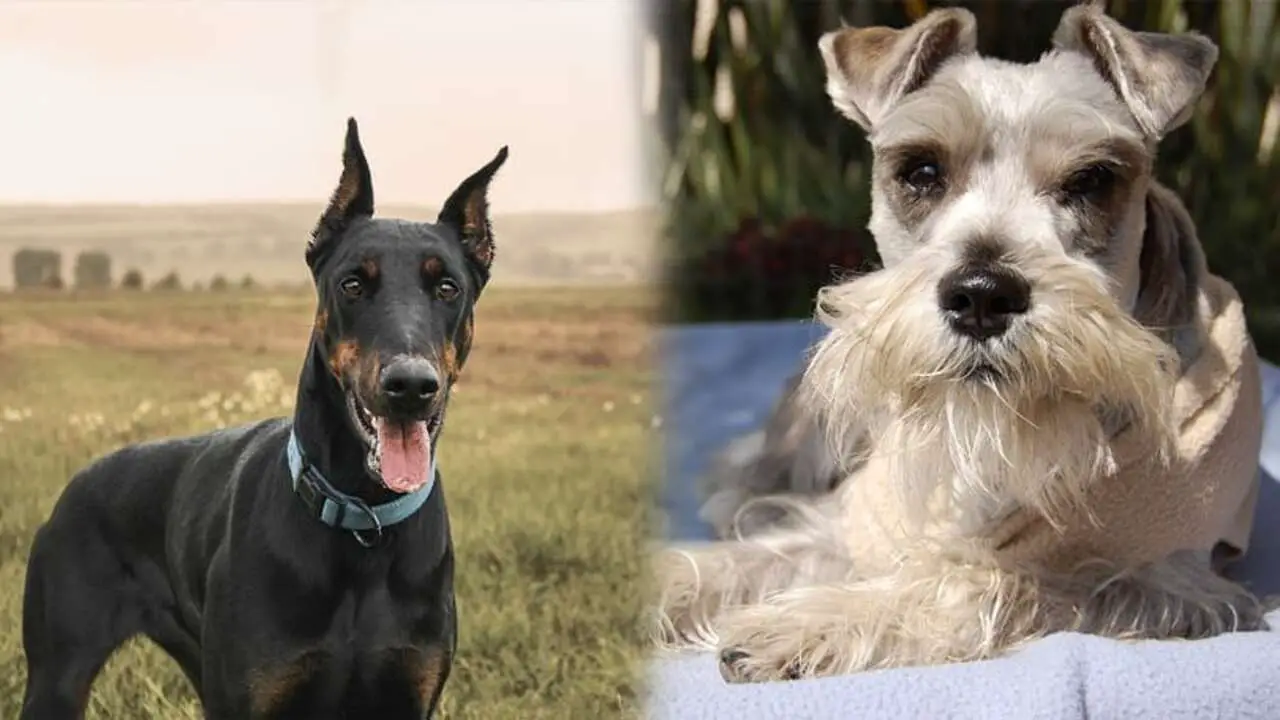
There are several factors to consider when comparing the Doberman and the Giant Schnauzer. Both breeds are known for their intelligence, loyalty, and protective instincts. However, there are some key differences between them. The Doberman is typically larger and more muscular than the Giant Schnauzer, with a sleek, athletic build. Here is the overview of Doberman vs giant schnauzer:
- Size: The Doberman is a large breed, typically weighing between 60-100 pounds, while the Giant Schnauzer is even larger, weighing 70-95 pounds.
- Temperament: Both breeds are known for their intelligence and loyalty. However, the Doberman is often described as more energetic and protective, while the Giant Schnauzer can be more reserved and independent.
- Exercise Needs: Both breeds require regular exercise to stay happy and healthy. The Doberman tends to have higher energy levels and may require more intense exercise, such as long runs or agility training. The Giant Schnauzer also needs plenty of exercise but may be content with a brisk walk or playtime in the yard.
- Grooming: The Doberman has a short coat that requires minimal grooming, while the Giant Schnauzer has a dense, wiry coat that requires regular brushing and occasional trimming.
- Trainability: Both breeds are highly trainable and eager to please. However, the Doberman may be slightly easier to train due to its high intelligence and willingness to work.
Comparison Chart:
- Doberman | Giant Schnauzer
- Size: Medium to large | Large
- Temperament: Protective, loyal, intelligent | Bold, energetic, dominant
- Coat: Short and sleek | Dense and wiry
- Colours: Black, brown, blue with rust markings | Solid black or salt-and-pepper
- Exercise Needs: High | Moderate to high
- Grooming Needs: Low | Moderate to high
While this chart provides an overview of some key differences between the two breeds, it is important to remember that individual dogs may vary in temperament and needs. Doing thorough research and consulting with breeders or experts when considering adding a new dog to your family is always recommended.
Physical Comparison
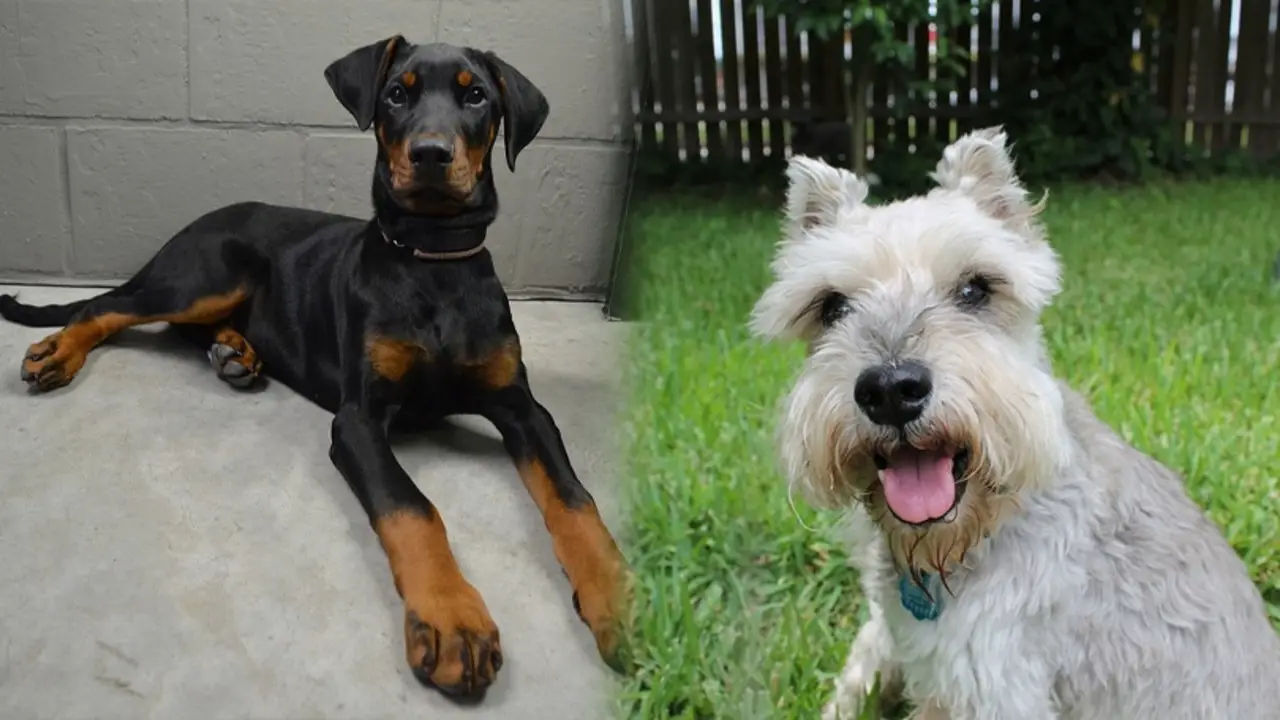
Knowing the physical comparison between a Doberman and a Giant Schnauzer is important for several reasons. It can help potential dog owners choose the breed that suits their lifestyle and living situation. For example, someone looking for a larger, more imposing dog for protection may lean towards the Doberman. Several key differences exist when comparing the physical characteristics of a Doberman and a Giant Schnauzer. Here is a breakdown of their physical attributes:
Doberman:
- – Size: The Doberman is a large breed, typically standing 24 to 28 inches tall at the shoulder.
- – Weight: They weigh between 60 to 100 pounds, with males on the larger scale.
- – Build: The Doberman has a sleek, muscular build, a deep chest, and strong legs.
- – Coat: Their coat is short and smooth and typically comes in colours such as black, red, blue, or fawn.
- – Ears and Tail: Dobermans have their ears cropped to stand erect. Their tails are often docked.
Giant Schnauzer:
- – Size: The Giant Schnauzer is also a large breed, standing about 23.5 to 27.5 inches tall at the shoulder.
- – Weight: They weigh between 60 and 85 pounds, with males slightly larger.
- – Build: The Giant Schnauzer is sturdy and powerful, with a deep chest and well-muscled body.
- – Coat: Their coat is dense and wiry, providing good protection against harsh weather. It usually comes in solid black or salt-and-pepper colour.
- – Ears and Tail: Unlike Dobermans, Giant Schnauzers typically have natural ears that are V-shaped and fold forward. Their tails are left intact.
It’s important to note that individual dogs may vary in size and appearance within each breed. When choosing between a Doberman and a Giant Schnauzer, it’s essential to consider their physical characteristics and temperament.
Temperament And Personality Traits
Dobermans and Giant Schnauzers have distinct temperaments. Dobermans are loyal, protective, and great guard dogs. Giant Schnauzers are also protective but more reserved with strangers. Both breeds are highly intelligent and trainable. Dobermans are eager to please their owners, making training easier.
Giant Schnauzers are independent and may require consistent obedience training. Dobermans are outgoing and friendly, enjoying interaction with people. Giant Schnauzers are affectionate with loved ones but reserved around unfamiliar faces.
When choosing between Dobermans and Giant Schnauzers, consider whether you prefer a loyal and protective dog or a more reserved companion. Both breeds offer unique characteristics that suit different households and lifestyles.
Doberman Traits
Dobermans possess abundant energy and necessitate regular exercise to keep them mentally and physically engaged. Their high energy levels and agility make them ideal candidates for various dog sports and activities. Dobermans interact well with children and can be exceptional family companions when appropriately trained and socialised.
They are known for their strong protective instincts and are frequently employed as police or military dogs. Despite their reputation as watchdogs, Dobermans thrive on companionship and attention from their owners.
Giant Schnauzer Traits
Giant Schnauzers are intelligent and versatile dogs, excelling as working dogs or family companions. They require regular exercise to prevent boredom and destructive behaviour. Their loyalty and devotion make them excellent guard dogs, always alert to potential threats. However, consistent training and socialization from an early age are crucial for well-behaved behaviour.
Giant Schnauzers have a strong prey drive, so they may not be suitable for households with small pets. Consider their compatibility with other animals in the household. Understanding the breed’s temperament and traits is essential for Standard Schnauzer or Miniature Schnauzer owners.
With proper training and stimulation, these dogs can thrive anywhere. Remember, every dog breed has unique characteristics; with Giant Schnauzers, consistency and positive reinforcement are key.
Training Needs And Exercise Requirements
The Doberman and the Giant Schnauzer require consistent and firm training to establish boundaries and prevent behavioural issues. The Doberman is known for its high trainability and intellectual stimulation, which makes them quick learners. On the other hand, Giant Schnauzers are intelligent but may have a more independent streak, requiring patience and consistent training techniques.
Both breeds need regular exercise to burn off their energy and prevent boredom. Engaging in obedience training, agility, or tracking activities can help positively channel their energy. By providing them with these outlets, you can ensure that they are mentally and physically stimulated.
Training A Doberman
Dobermans are intelligent and eager to please, making them highly trainable. Positive reinforcement techniques like rewards and praise work best. Consistency and patience are key when setting rules and boundaries. Socialization is crucial for their behaviour in different settings. Obedience training controls their protective instincts and prevents aggression.
Doberman Pinschers excel in protection training and as police dogs. Early training and socialization are essential for puppies. Regular brushing and exercise maintain their health and happiness.
Training A Giant Schnauzer
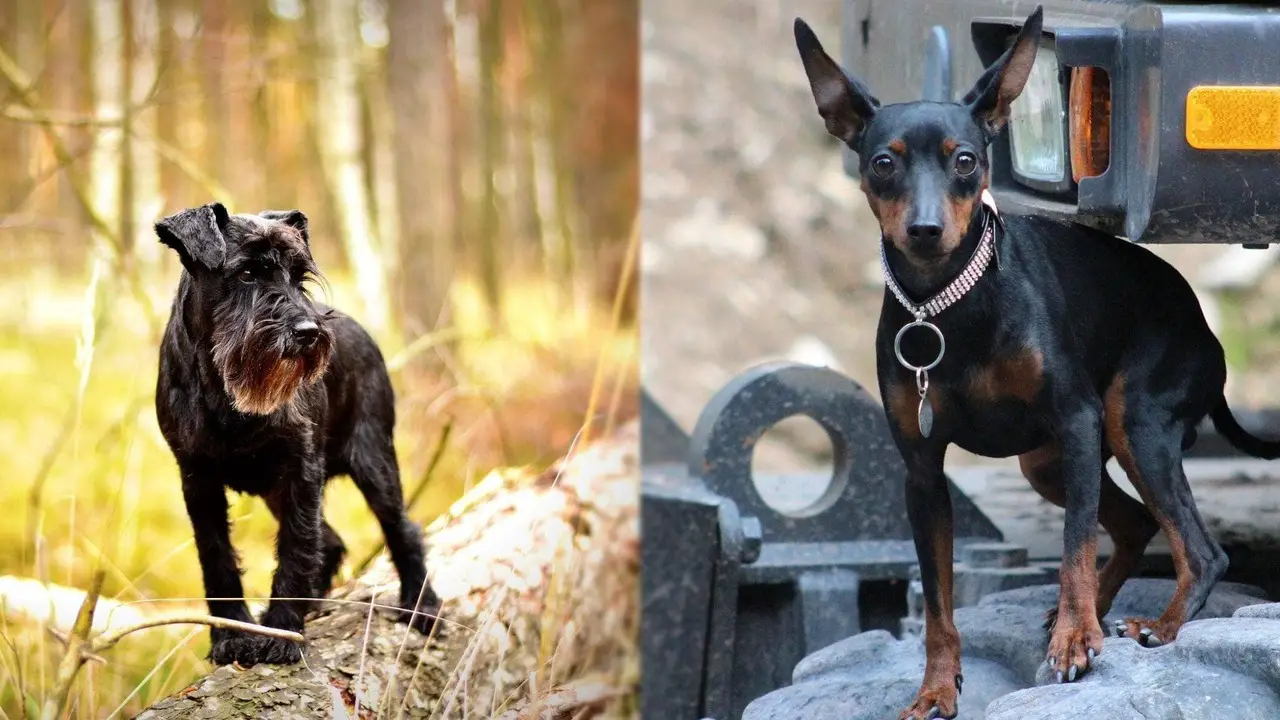
Training a Giant Schnauzer requires consistent and firm techniques to cater to their intelligence. Positive reinforcement is effective, although this breed may also respond well to more assertive training methods. Early socialization plays a vital role in preventing aggressive tendencies in Giant Schnauzers.
Due to their strong prey drive, providing them with extra training is important to avoid chasing smaller animals. Engaging their minds through activities like puzzle toys or interactive games can help keep them mentally stimulated. By incorporating these techniques, you can ensure that your Giant Schnauzer is well-behaved and obedient.
Health Concerns And Lifespan
The Doberman and Giant Schnauzer breeds are generally healthy but may have specific health concerns. Regular veterinary check-ups, a balanced diet, and responsible breeding practices can help maintain their well-being. They have an average lifespan of 10 to 12 years.
Exercise, nutrition, grooming, and awareness of potential health issues are important for their overall health. By following these practices, you can minimize the chances of encountering significant health issues with your Doberman or Giant Schnauzer and ensure they remain healthy and happy for years.
Common Health Issues In Dobermans
Like other dog breeds, Dobermans can be prone to certain health conditions such as dilated cardiomyopathy, von Willebrand’s disease, hip dysplasia, and hypothyroidism. Regular exercise and weight management can help minimize the risk of joint problems like hip dysplasia.
Routine eye exams are recommended to check for progressive retinal atrophy. Responsible breeding practices and choosing a reputable breeder can reduce the risk of inherited health issues. Taking care of your Doberman’s health is crucial for their long and happy life.
Common Health Issues In Giant Schnauzers

Giant Schnauzers are prone to certain health conditions. Hip dysplasia can cause discomfort and mobility issues, while bloat is life-threatening. Eye problems, such as cataracts or progressive retinal atrophy, can lead to visual impairment or blindness.
Regular exercise and weight management are crucial for maintaining joint health. Routine grooming prevents skin issues and maintains their dense coat. Responsible breeding practices and genetic testing reduce the risk of inherited health conditions. These precautions will help ensure that Giant Schnauzers live long, healthy lives.
Which Breed Is More Suitable For Families?
The Doberman and Giant Schnauzer are excellent choices if you’re considering a four-legged friend. The Doberman is fiercely loyal and protective, making it an ideal guard dog. They’re intelligent and easily trained but require exercise and mental stimulation.
The Giant Schnauzer is playful and affectionate, perfect for families with children. They’re highly intelligent and love learning new things. However, regular grooming is necessary to maintain their long coat.
Both breeds make great watchdogs due to their protective instinct. Early socialization is crucial for their development. Choosing between a Doberman or Giant Schnauzer depends on your lifestyle, personality, and the type of furry companion you desire!
What Are The Grooming Needs Of These Breeds?
Dobermans and Giant Schnauzers have different grooming requirements. Dobermans have short coats and require low-maintenance grooming. On the other hand, Giant Schnauzers need regular brushing and professional grooming for their longer coat.
However, both breeds need consistent grooming to keep their coats healthy. Regular brushing removes tangles, dirt, and loose fur while distributing natural oils. Grooming sessions also allow checking skin and coat issues like dryness or hot spots early on. Regular grooming promotes bonding between pet and owner and keeps them looking their best.
Living Conditions Best Suited For Each Breed
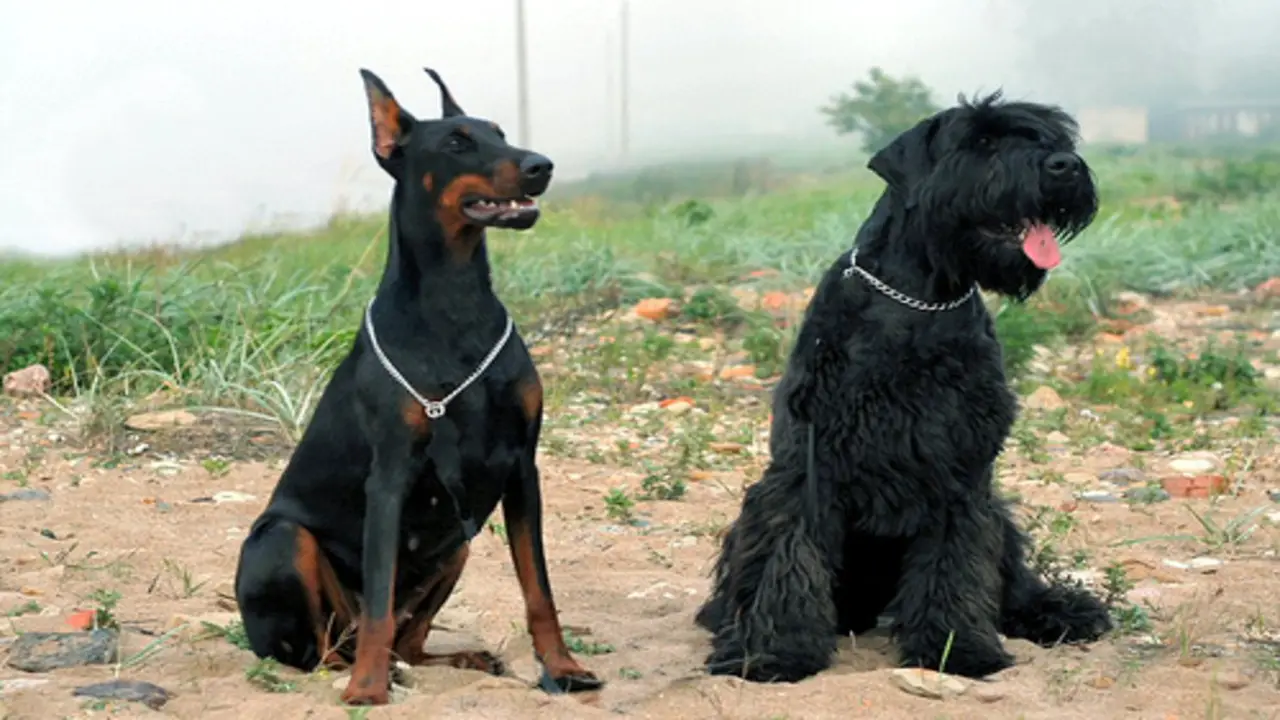
The Doberman and the Giant Schnauzer have specific living conditions that suit their needs. The Doberman needs an active household with a fenced yard for ample space to run and play. The Giant Schnauzer requires a spacious home with a large backyard to stretch its legs. Both breeds need exercise and outdoor access. Consider these conditions when choosing the right breed for your lifestyle.
Conclusion
Both Dobermans and Giant Schnauzers have their unique qualities and characteristics. Understanding the differences in physicality, temperament, training needs, health concerns, and suitability for families is essential in making an informed decision. Consider your lifestyle, living conditions, and grooming capabilities before choosing the breed better suited for you.
Both breeds require dedicated training, exercise, and attention to thrive. Whether you opt for a doberman vs giant schnauzer, providing them with love, care, and a nurturing environment will ensure a happy and fulfilling companionship for years to come. Take the time to research and consult with experts or breeders to make the best decision for you and your family.
Frequently Asked Questions
Are Dobermans And Giant Schnauzers Good With Other Pets?
Regarding other pets, both Dobermans and Giant Schnauzers can be trained to get along. Early socialization is essential for good behaviour. Supervision and proper handling by the owner are crucial to prevent any potential issues.
Is A Doberman Or A Giant Schnauzer Easier To Train?
Both Dobermans and Giant Schnauzers are intelligent breeds that can be trained successfully. Dobermans are eager to please and respond well to positive reinforcement. On the other hand, Giant Schnauzers can be more independent and require firm yet gentle training.
Are Giant Schnauzers Related To Dobermans?
Giant Schnauzers are not related to Dobermans. Although both breeds were developed in Germany, they have different histories and characteristics. Dobermans are smaller and more athletic, while Giant Schnauzers are larger and more protective.
Will A Giant Schnauzer Protect You?
Giant Schnauzers are known for their protective nature. They make excellent guard dogs due to their intelligence and trainability. Proper socialization and training are essential to ensure a well-behaved and effective protector.
Do Doberman Pinschers Make Good Family Dogs?
Doberman Pinschers can make excellent family dogs when properly trained and socialized. Their loyalty, intelligence, and protective nature make them an ideal family choice. However, supervision is important when children are around to prevent any accidents.

Aquarium passion is all about connecting with the aquatic life and providing education to the public on the importance of these creatures. We showcase a wide variety of marine life through our exhibits as well as working with schools to provide unique learning opportunities for students of all ages.

